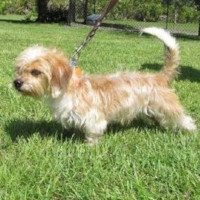Appearance of the Schweenie
|
| The long-haired, majestic Shih Tzu and the long-legged, fleshy Dachshund are two small breeds that don't look alike. As a result, the Schweenie breed has many physical variations. Most will have a long back with a belly close to the ground due to their short, often sloping limbs. Their skulls are relatively small and can be domed or flattened at the forehead. Their soft ears hang close to their faces and are widely separated. Their eyes are round and dark brown, which often gives them the impression of pleading for something. Their muzzle is of medium length, ending in a clean, black nose. Their tail is not too long and will taper to a point. It is often carried straight when the dog is active. Once mature, the Schweenie will weigh between 4 and 9 kilos and measure between 28 and 38 centimeters. Their body is compact and rather dense. Some Schweenies will have longer coats than others, but most will have a medium-long, wiry coat that can come in a variety of shades, including brown, white, black, fawn and gray. Bicolored and tricolored dogs are common and preferred by many owners. Some will have longer fur around the face and may even have a moustache and beard. |
Temperament of the Schweenie
|
| A dog designed to be a family pet, the Schweenie is the ideal companion for children and adults alike. Friendly and always eager to please their owners, Schweenies are not difficult dogs to handle if properly trained. With proper socialization, these guys can integrate with people of all sizes, as well as other dogs. However, assuming that they will be socialized automatically is unrealistic because, like any breed, it takes time. It's not uncommon for a Schweenie to develop separation anxiety. This is particularly the case with those who become strongly attached to a particular owner and spend a lot of time without human company. Wherever possible, we should strive to prevent this anxiety from developing by seeking to breed a well-developed dog that is not overly dependent on one particular owner. Confined training can also be a useful tool. Wherever possible, these dogs need to be surrounded by humans, and are therefore unsuitable for homes that are often empty. More intelligent than the average canine, this characteristic works in the Schweenie's favor when it comes to training, but can make them overly sensitive. Under-stimulated, these dogs carry quickly and can become destructive in the home. Similarly, excessive barking can become a problem for some. |
Needs and activities of the Schweenie
|
| The Schweenie is not a very active dog. He'll enjoy a brisk walk with you around the neighborhood, but on rainy days he's just as happy to run free inside the house. Provide him with toys that will stimulate his mental abilities. He'll spend days at the dog park, but remember that he'll need to be fully trained before releasing him from his leash for free play. He also needs to be socialized with other animals before being surrounded by strange dogs. He'll appreciate being able to play in a fenced-in area under your supervision. At no time should he be allowed to get too hot or overworked. Keep water on hand for exercise on hot, humid days. |
Maintenance of the Schweenie
|
| The Schweenie will need a little maintenance. Brush it two or three times a week to remove excess hair. In spring and autumn, you may need to brush him daily to avoid excessive hair on your clothes and furniture. His floppy ears may need special attention from you. Wipe his ears with a damp cotton ball once a week. Check for odor or redness, which indicates an ear infection. Brush his teeth two or three times a week to prevent tartar build-up. However, to avoid bad breath and tooth decay, brush every day. Trim his nails twice a month, unless he wears them out on his own. As a general rule, if you hear his nails clicking on the tiles or parquet, it's time to trim his nails. Start a grooming routine when he's young. Some dogs are sensitive to touch, and getting him used to this routine will be beneficial as he grows. |










 English (United Kingdom)
English (United Kingdom)